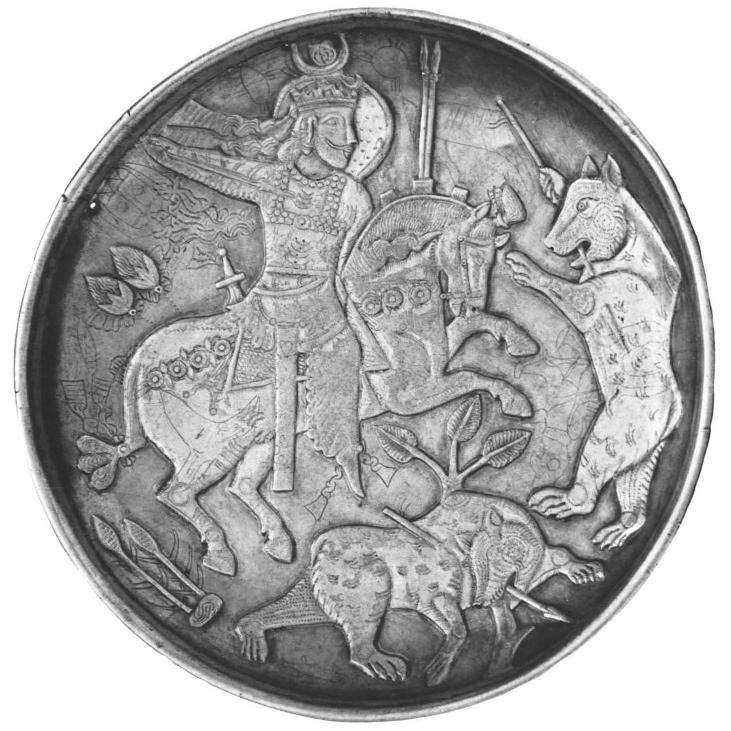
Amazon Audible Gift Memberships
Sasanian silver plate from Anikovska. Khusro I hunting bears. Middle or end of the sixth century. Pushkin Museum, Tcherdyne, Russia.

A larger image of this Sasanian silver plate from Anikovska.


Silver plate from Anikovska. King hunting bears
Pushkin Museum, Tcherdyne
Photo: V. G. Lukonin
Plate 21 in: Harper, Prudence and Meyers, Pieter Silver Vessels of the Sasanian Period. Volume One: Royal Imagery, The Metropolitan Museum of Art, Princeton University Press, New York, 1981
70
Anikovska plate (PL. 21). Somewhat more conservative in design but stranger still stylistically is a plate found at Anikovska in the Ural mountain region in the Soviet Union.146 A king wears the same crown as on the two preceding plates (Pls. 19, 20), with the notable exception that the band has only a single line of beading. The king, astride a rearing horse, is thrusting a spear toward his quarry. In this case an invisible left hand holds two other spears on the far side of the horse's neck.147 Before the horse, and facing it, is a rearing bear that attempts to pull a spear from its own body with its paws.148 Horizontally placed beneath the horse is a dead bear transfixed by another spear. A small tree rises behind this animal, and reeds, shown schematically as a single pair rising from a spiral of water, are beneath the horse's hind legs. The scene fits within the circular plate.
The king, in pure right profile, has a halo behind his head and a simple, cloth-covered, undecorated globe. Otherwise his dress differs little from that of the Berlin hunter (P1. 20), except for the row of crescents running down the center of his chest, the abrupt right angles of the halter straps, and the hearts decorating the quiver. The belt has rectangular clasps. The king's earring is a type seen on Eastern coins of Bahram V, on coins of Bahram VI, and on a late Sasanian clay sealing from Qasr-i Abu Nasr. In rare instances, it occurs on coins as early as Bahram II.149
The horse has a crenelated mane, and his head is turned, as on the Berlin plate (P1. 20), so that the second ear is visible. The tail is bowed. Circular phalerae decorate the saddle bands and the flaring lines of the blanket (unusual in shape) can be seen before and behind the rider.150 Hair balls of the normal type rise above the horse's back. The hind-leg muscles of the horse are shown as paired lines, and either a tamga or a muscle pattern is on the chest.
At intervals on the bodies of the bears are tufts of hair, a schema that has previously been associated with boars (Pl. 15). Reeds and water also are customarily found with boars, not bears. (This confusion of the two animals is apparent on late Sasanian seals, where it is often difficult to distinguish the heads of boars and bears.)151 In the usual fashion, the inside surface of the leg is treated differently from the rest of the body. In this instance, it is covered with rows of dots. The heads of the bears have an elaborated dotted spiral pattern as well.
Nothing is known of the method of manufacture of this plate, although it would appear from photographs that none of the pieces is added. The relief must therefore have been achieved by carving away the background or through casting. It is also impossible to see in the photographs which of the areas are gilded, and this is not specified in the publication.
146. Pushkin Museum, Tcherdyne; diam. 21 cm. weight 841 gm; found in May 1967, Lunegov, "Sasanidskoye blîudo iz Prikamia," pp. 256-258. Lunegov identifies the king, according to his crown as Khusro I, and the plate is dated to the middle or end of the sixth century.
147. This pose is reminiscent of that of Bahram II on a rock relief at Bishapur: Ghirshman, Bîchâpour I, pl. 16.
148. This is a conventional pose that occurs in a similar scene on a mosaic found at Carthage dating from the fourth century AD.: Poinssot and Quoniam, "Bêtes d'amphithéâtre sur trois mosaïques du Bardo," p 146, fig. 8.
149. The Bahram V coin with this feature is in the American Numismatic Society; Frye; Qasr-i Abu Nasr, p. 67. Göbl, Sas. Num., pl. 4, no. 62 (Bahram II Coin).
150. This feature appears on a Hephthalite bowl in the British Museum dated around 450-460 by Marshak and Krikis: Dalton, Oxus pls. 29-31, no. 201; Marshak and Krikis, "Chilekskie Chashi," p. 71. It also occurs on silver hunting vessels generally attributed to a period after the fall of the Sasanian dynasty: Orbeli and Trever, Sas. Metall, pls. 3, 12, 15.
151. See Harper in Frye. Qasr-i Abu Nasr, p. 75.
Source: Plate 21 in Harper, Prudence and Meyers, Pieter Silver Vessels of the Sasanian Period. Volume One: Royal Imagery, The Metropolitan Museum of Art, Princeton University Press, New York, 1981